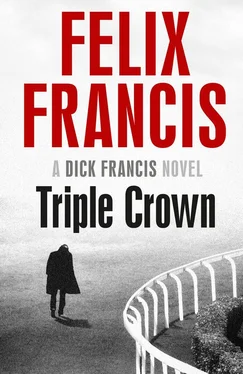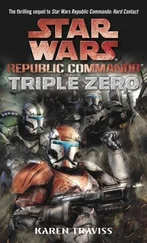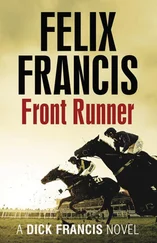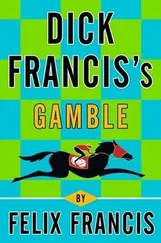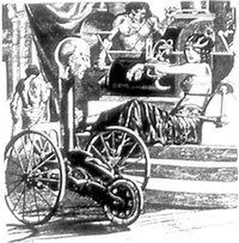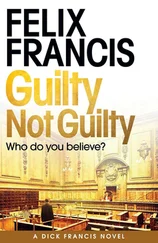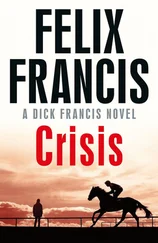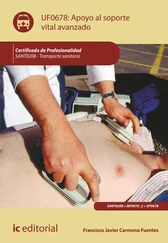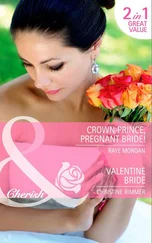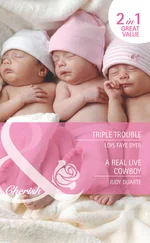‘We’ve been scrambled,’ she said. ‘There’s trouble at the track.’
I dressed in record time and made it onto the last of the black Suburbans to leave, one driven by Cliff Connell and also containing Special Agents Trudi Harding and Justin Pickering.
‘What’s the trouble?’ I asked.
‘We’re not sure,’ said Cliff over his shoulder. ‘Norman got an urgent call from the State Racing Commission saying they needed our help.’
We raced past a large lit-up sign on a pole that showed it was 6.15 a.m. and 52 degrees. I must have slept longer than I realised. The sky was even becoming light in the east.
The backside was a hive of activity when we arrived, with sheriff’s deputies, Louisville Police and the FACSA agents all pacing around the barns not really knowing what they were looking for.
I came upon Norman standing next to one of the Suburbans.
‘What’s happening?’ I asked.
‘Three Derby horses are sick,’ he said.
‘Is that all?’ I said. ‘With all this fuss, I thought someone else must have died.’
‘They’re three of the most favoured runners. The trainers are claiming they’ve been got at.’
‘Is that what you think?’ I asked.
‘I’ll wait for the test results,’ Norman said. ‘The veterinarians are taking samples. There’s a rumour it might be EI.’
EI, or equine influenza, was a much-feared disease in the racing world, and for good reason. Highly infectious through the air, and with an incubation period of only a day or two, it could spread through a horse population like a bushfire in a drought. Its appearance at a major centre like Churchill Downs, where the training barns were packed so tightly together, could easily shut down racing here for weeks.
In August 2007, four stallions arrived in Australia from Japan, where there had recently been an outbreak of EI. As was normal practice, the stallions were transferred to a quarantine centre near Sydney Airport.
On the twenty-fourth of August, tests confirmed that several horses at the quarantine centre were infected with the H3N8 subtype of the equine influenza virus.
Even though the affected animals were supposed to be isolated from the general horse population, new cases of the same subtype were simultaneously reported at a nearby equestrian centre. Although never proven, the official report assumed that the virus had been transferred accidentally on the tools of a farrier who had attended to horses at both sites.
The following day some eighty horses were found to be sick and, by the end of August, just one week after the first instances, 2,000 horses were unwell with the disease. Movement of horses throughout Australia was banned without a permit and many equestrian events were cancelled, including the Sydney spring racing festival. At the peak of the outbreak, more than 47,000 horses across New South Wales and Queensland were infected and horse-industry operations did not return to normal for almost a year.
To lessen the likelihood of such epidemics, all racehorses in the United States and Europe have to be vaccinated and then given regular six-monthly boosters but, as in humans, the influenza virus can mutate, rendering the vaccine useless.
The outbreak of a new variant, even this close to the race, would put the Derby itself in jeopardy. No wonder the Kentucky Horse Racing Commission was running round in panic mode.
All morning exercise on the track was cancelled and the media circus, which had arrived to cover it, instead spent their time speculating as to what might happen next. Multiple TV crews busily set up at various locations between the barns, much to the alarm and dismay of everyone else, who worried that they might help spread the plague yet further.
An impromptu press conference was called for eight o’clock and everyone crammed into the tented press centre situated next to the track to listen.
The nervous-looking racing commissioner sat alone at a table with a microphone set up in front of him. ‘Ladies and gentlemen,’ he began, ‘let me start by assuring you that the Kentucky Derby will go ahead later this afternoon as planned.’
There was a collective sigh of relief from the assembled media, and a round of applause from the many owners, trainers and jockeys who were squeezed in at the back.
The commissioner waited for silence before continuing. ‘Early this morning, at around five a.m., three horses that had been due to run in today’s Derby didn’t eat up their food and were found to be showing signs of sickness. The horses in question were immediately placed in isolation and, as of just now, no further cases have been reported. However, on veterinary advice, those three have been scratched from the Derby. As it is now past the deadline for replacements, only seventeen runners will go to post.’
‘Is it equine influenza?’ shouted one reporter from the front row.
‘As yet, we have no indication of the disease,’ said the commissioner, ‘but we wish to remind you that all US racehorses are routinely immunised against equine influenza.’
‘So are you saying it is not influenza?’ asked the reporter.
‘Er… no, I’m not. It may be a new strain. We will all have to wait for the results of blood tests.’
He didn’t exactly exude confidence, but he changed direction by then naming the scratched horses and, as Norman had indicated, they were three of the four most favoured for the win.
Was it just the way my mind worked, or was that rather convenient for the fourth?
Life in the backside returned to normality, if that was the right term for the excitement generated by Derby Day morning at Churchill Downs.
The remaining seventeen Derby hopefuls were trotted up in turn in front of the state senior veterinary officer for him to decide whether each animal was sound and also, in the light of what had occurred earlier, for them to have their temperatures checked. Fortunately, after a thorough inspection, all were declared well and fit to race.
After the medical examination each was then presented to the press in what can only be described as a beauty pageant for horse and owner.
Occasionally, in England, especially at the Cheltenham Festival, connections of a particular horse might wear a necktie in similar shades as their racing silks, or perhaps a knitted scarf in comparable tones — nothing too ostentatious, you understand.
There was clearly no such restraint in Kentucky.
One of the Derby owners was decked out in a three-piece suit cut from cloth boldly printed with his green-and-yellow racing colours, complete with matching tie, baseball cap and even coordinating green-and-yellow-striped shoes. The poor horse looked positively embarrassed to be standing next to him for the photographs. But there was more. The owner’s wife and family were similarly attired in green and yellow and, in case you couldn’t work it out, each of them wore a huge button badge with the name of their horse printed large across it.
And the man was as brash as his outfit, telling all the assembled press that his baby was a certainty to trot up and collect the trophy. None of them really believed him as the horse in question was one of the rank outsiders, but that didn’t seem to dampen the owner’s enthusiasm.
Meanwhile, away from the limelight of the press parade, I watched behind the media tent as another owner, inconsolable in his grief, was trying to come to terms with the fact that his prized Thoroughbred star, strongly tipped to be a Triple Crown winner, would now not even get to the starting gate of the first leg.
It is not generally polite to stand and watch a grown man cry, but I felt sorry for him. Only a handful of racehorse owners ever have the privilege of owning a potential champion and this man’s dream of glory had been snatched away by a virus so small he would need an electron microscope to see it.
Читать дальше
